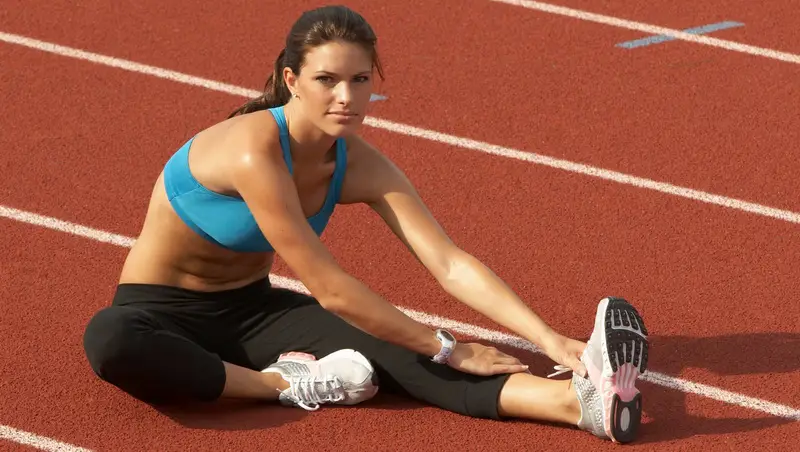Embarking on the open road or trail brings both exhilaration and challenge to every runner.
But to truly thrive in this dynamic sport, one must embrace the importance of flexibility and mobility. In the pursuit of peak performance and injury prevention, integrating effective stretches into your routine is non-negotiable.
Welcome to our comprehensive guide to the '10 Best Stretches for Runners.' Whether you're a seasoned marathoner or a beginner hitting the pavement for the first time, this curated selection of stretches is designed to enhance your running experience, improve your stride, and keep you moving with ease.
Join us as we delve into each stretch, exploring not only their techniques but also their benefits and the science behind them. From targeting tight hamstrings to alleviating IT band discomfort, these stretches are your ticket to a smoother, more enjoyable journey on your running path.
So lace up your shoes, roll out your mat, and let's dive into the world of stretching, where each bend and twist brings you one step closer to unlocking your full running potential."

1. Dynamic Leg Swings
Dynamic leg swings are a fantastic way to warm up before a run or any sports activity. They help to prepare your muscles and joints for the movements to come. To begin, find a stable object or wall to hold onto for balance. Stand on one leg and gently swing the other leg forward and backward. Ensure each swing gradually increases in range as your muscles become more flexible. This exercise effectively warms up your hip flexors, hamstrings, and glute muscles—all vital in achieving effective running form and preventing muscle strain.
Try performing 10 to 15 swings per leg before starting your workout. Remember, the goal is to invigorate the muscles through a full range of motion, so keep the movement controlled and steady. Over time, include sideways movements in your routine to further enhance agility and muscle responsiveness. The simplicity of dynamic leg swings, coupled with their benefits, makes them an essential starting point for any exercise routine, ensuring you keep your motions fluid and your runs efficient.
2. Walking Lunges
Begin by standing upright with your feet together and take a step forward with one leg, lowering into a lunge until both knees form right angles. Ensure your front knee is aligned with your ankle, not pushing forward over your toes to keep the strain off your knee joints. Press down through the heel of your front foot, lifting yourself back up and stepping forward into a lunge with the opposite leg.
Performing walking lunges across a certain distance or doing 10 to 12 lunges for each leg before your run can greatly assist in developing muscular endurance. Plus, it's particularly good for activating those key leg muscles in a way that mimics the actual movement of running but with an added element of control and power.
To add variety and challenge, try incorporating weights such as a pair of dumbbells or a barbell placed over your shoulders. This enhancement isn't just beneficial for strength; it helps improve running posture, balance, and coordination—core elements that significantly determine your capacity to run longer distances with improved stability and effectiveness.
Integrating walking lunges into your daily routine will bring a new vigor to your strides and uplift your mood. It's a rewarding stretch that primes your body not just for the run, but for achieving fitness mastery and a positive mindset.
3. Butterfly Stretch
Allow your knees to naturally fall closer to the ground as you gently coax them—no forcing or rushing the movement. As you lean slightly forward, maintaining a straight back, breathe deeply and focus on the release spreading across your inner thigh muscles. This isn't just about pushing limits; it's about setting your pace, understanding your body's boundaries, and letting your breath guide you deeper into relaxation and recovery.
When performing this stretch, envision the smooth, graceful glide of a butterfly's flight. Let those qualities translate into your stretch. Hold the pose for about 30 to 60 seconds and appreciate the release as lactic acid washes away from your tired muscles. This peaceful moment post-run brings needed flexibility enhancements and a moment of tranquility for mental unwinding. Think of it as a brief meditative repose for your mind, returning care to your body after your run.
Adding the Butterfly Stretch regularly into your cooldown routine accentuates your journey beyond routine workouts to a personal celebration of limits discovered and gently, persistently expanded. It serves as a quiet yet potent ally that beckons your stride to be more fluid, your mindset wider, and your running philosophy enriched by the care extended to both body and spirit through thoughtfully selected stretches. Embrace the Butterfly for what it offers - a smoother run, a more supple gait, and a more holistic approach to hitting each mile with an appreciative smile.
4. Calf Raises
You are at the edge of stepping up your running game—standing on a step with just enough space to rise and dip each foot. That's the essence of calf raises, a practical exercise for cultivating robust calf muscles, those important supporters in every runner's life.
Start by positioning the balls of your feet on the edge of a step, heels hanging off. With a straight posture and focus, press upwards lifting onto the tips of your toes. Feel the calf muscles contract, embodying the power they harness. Hold this raised position for a moment, then slowly lower your heels below the step level to stretch and engage even more muscle fibers.
Include calf raises in your routine about two to three times a week, aiming for three sets of 15-20 reps per leg, to see substantial gains in strength and endurance. This simple but mighty exercise ensures that, come race day or hilly escapade, you have cultivated the power behind every stride—a combination of steadiness and sprint ready to take on miles with muscular confidence and zest.
5. Foam Rolling for IT Band Relief
Your legs, often subjected to the rigorous demands of running, need a little TLC. Enter the magic of foam rolling your IT Band, an activity that can sometimes feel like a deep tissue massage. Position yourself on the floor with a foam roller under you, aligning it with your thigh's side. Then, move your body so that the roller travels from just above your knee to right below your hip.
This rolling ritual, albeit a bit uncomfortable at first, works wonders in ironing out the kinks along your fascial line. The IT Band, being susceptible to overuse, tightens up. By incorporating this practice into your post-run regimen, you alleviate build-up, avoid potential stiffness, and keep those leg muscles tuned.
Consider making foam rolling a non-negotiable part of your cooldown—a few minutes spent on this can amplify your recovery and enhance muscle elasticity.
6. Hip Flexor Stretch
Let's explore the fundamental world of stretching targeting the hip flexors - considered crucial in the art of running. Kneel into a lunge position where the universe of muscle tension dissolves into realms of refreshment and rejuvenation. Propelling your hips forward, a true symphony of stretching begins! Here in this hold, simmering quietly within are your hip flexors, unwinding. Thirty seconds - that's all it takes. Each second increases hip flexibility, refines running posture, and collectively sighs relief from the anticipatory tension of injuries.
7. Quadriceps Stretch
The Quadriceps Stretch, danced by runners seeking solace for their hardworking muscles. Start by standing tall as if the winds of your last run left you imbued with pride. Gracefully bend your knee to bring your foot towards your buttocks, achieving a pose that rivals even the finest sculptor's work. Now, capture your ankle with your hand, a gentle yet firm clasp, a reassurance that you can balance even when weary.
As you hold this stretch, ensure your knees are touching or nearly so. Then, coax your hip forward. Feel that extension happening right at the front of your thigh? That's your quadriceps being treated to a wellness retreat, right in the haven of your post-run cooldown.
This isn't just about muscle recovery—it's your moment of victory, keeping knee troubles at bay. Hold this posture for 30 seconds. Release gently, shifting now to the other leg, curating balance in muscles and in your running story.
8. Piriformis Stretch
Nestle into the Piriformis Stretch, a secret weapon in the runner's arsenal for tackling tightness in those glutes. Sit with one leg crossed over the other—this pose is the opening chapter of a tale where balance and flexibility reign supreme. Keeping that back straight, guide your knee toward the opposite shoulder. This isn't merely a movement; it's a narrative of deliberate and tender negotiation with your own body's boundaries.
As you coax your knee across, pay heed to the ease of this discourse. No coercing, just a clear, consensual dialogue between muscle and movement to achieve a stretch so divine, it unravels the tight tales woven by sciatica-like symptoms. Sit there, folded yet unfazed.
This stretch is an ode to the piriformis muscle itself—a small yet mighty performer in the ballet of your daily sprints and marathons. As effective as this stretch is in dispatching discomfort, it also corners an often overlooked narrative of preventative care. Incorporate it into your post-run stretching rite.
9. Spinal Stretch
The Spinal Stretch is a crucial exercise for runners, helping to improve flexibility and resilience in the back. To perform this stretch:
- Lie down on a soft mat facing upwards.
- Bend your knees and gently let them fall to one side, while turning your head to the opposite direction.
This twisting motion helps to decompress the spine, providing relief to tight muscles and tendons. It promotes tranquility and relaxation, allowing you to release tension built up from running.
10. Downward Dog
The Downward Dog is a foundational stretch that benefits both seasoned runners and casual joggers. To perform this pose, start by folding forward with your hands and feet firmly on the ground, pushing your hips upwards to form an inverted V shape.
This pose stretches the entire back of the body, from the heels through the calves and up to the hamstrings. It also strengthens the spine, shoulders, and arms, preparing them for the challenges of running.
As you hold the pose, allow each breath to wash over you, smoothing out stresses and rejuvenating your body. Keep your gaze downward, centering your focus and allowing for subtle adjustments that promote stability.
Hold the pose for 30 to 60 seconds, feeling the tension release from your muscles. You can also add variations, such as lifting one leg or bending your knees, to challenge your balance and target specific areas.
Incorporate the Downward Dog into your post-run cool-down or pre-run warm-up routine. Each time you practice this stretch, you'll be realigning your body, promoting a sense of calm, and preparing yourself for the miles ahead.
---
Home -> Fitness For Beginners -> Stretching -> 10 Best Stretches for Runners



